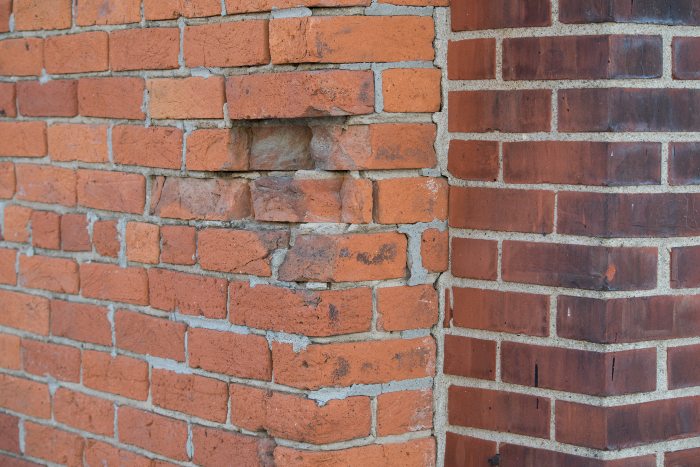Tuckpointing vs Repointing
Masonry structures, whether made of brick, stone, or other materials, need regular maintenance to maintain their structural integrity and preserve their visual appeal. Among the practices in the upkeep of these structures are tuckpointing and repointing, two distinct yet essential techniques. While often mentioned together and sometimes considered synonymous, tuckpointing and repointing serve different needs and involve unique procedures.
Both of these methods are important in extending the lifespan of masonry structures. Regular tuckpointing and repointing can prevent significant deterioration caused by environmental factors like weathering and erosion. This helps in avoiding costly repairs and maintaining the building’s structural safety. Let’s learn more about repointing and tuckpointing.
Repointing and Tuckpointing: What’s the Difference?
Repointing and tuckpointing are both methods used to maintain and repair masonry joints, but they are different in their purpose and technique.
Repointing is the process of renewing the external part of mortar joints. Over time, weathering and decay cause voids in the joints between masonry units, usually bricks, allowing the undesirable entrance of water. Repointing involves removing the damaged mortar and replacing it with new mortar, essentially restoring the masonry’s structural integrity and preventing water ingress.
Tuckpointing, on the other hand, is a more aesthetic technique that involves applying a second, thin line of fine, usually white or colored, mortar into the center of freshly repointed mortar joints. The primary goal of tuckpointing is to mimic the look of finely jointed masonry, giving an artificial impression of very fine joints within the masonry. It is often used to enhance the visual appeal of the structure.
The Process of Repointing
Repointing is a meticulous process that involves several steps:
- Mortar Removal: The first step is to carefully remove the old, damaged mortar from the joints to a required depth using tools like grinders, chisels, and hammers.
- Cleaning Joints: After removing the mortar, the joints are cleaned of any remaining debris to ensure a clean surface for the new mortar to adhere.
- Mortar Matching and Preparation: It’s crucial to match the new mortar to the existing one in color, composition, and texture. Once matched, the mortar is mixed and prepared for application.
- Filling Joints: The new mortar is then carefully applied to the joints, ensuring it is compacted and shaped to match the original joint profile.
- Curing: Finally, the mortar is allowed to cure, forming a strong bond that restores the masonry’s integrity.

The Process of Tuckpointing
Tuckpointing involves the following steps:
- Repointing: Tuckpointing begins with the process of repointing as described above.
- Applying Fine Line: Once the repointing mortar is set, a fine line of contrasting mortar is applied in the center of the newly filled joints.
- Striking and Finishing: This fine line is then carefully shaped and smoothed to create a sharp, aesthetically pleasing look.
How Much Does Tuckpointing or Repointing Brick Cost?
The cost of tuckpointing or repointing can vary widely depending on several factors such as the location, size of the area, condition of the masonry, and labor rates in your region. On average, repointing might cost anywhere from $5 to $25 per square foot, while tuckpointing, being a more detailed and decorative process, could cost slightly more. The professionals at ROCK’N-IT Masonry are happy to provide you with a free estimate based on the specific conditions of your structure. Contact us today to schedule your consultation.
How Often Should Repointing Be Done?
The frequency of repointing depends on various factors including the type of mortar used, the building’s exposure to harsh weather, and the quality of the original work. Typically, a well-done repointing job can last anywhere from 25 to 30 years. Regular inspections of masonry joints for signs of wear and deterioration can help in determining when repointing is necessary.
How Long Will Tuckpointing Last?
The lifespan of tuckpointing is similar to that of repointing, as the underlying repointing work plays a significant role in its durability. Tuckpointing can last for several decades, provided that the repointing base is of good quality and the masonry is well-maintained. However, the aesthetic aspect of tuckpointing may fade or discolor over time, depending on environmental exposure and the quality of materials used.
Both tuckpointing and repointing are important techniques in the maintenance of masonry structures. While repointing is primarily concerned with the structural integrity and longevity of masonry, tuckpointing enhances its visual appeal.
If you want professional masonry cleaning, contact us today. At ROCK’N-IT Masonry, we specialize in top-notch masonry and home improvement services, proudly serving Weber, Davis, Salt Lake, and Utah Counties. Our team is renowned for their unrivaled craftsmanship in brick, rock, and stonework. We handle every project, from intricate new builds to precise repairs, with the finesse and dedication of true artists. Our approach ensures that each task, no matter how small, receives the expert attention of our highly skilled masons. We are committed to surpassing your expectations, offering quick response times, competitive pricing, and exceptional workmanship. Our focus is on quality, not speed, ensuring that every job is completed correctly. Trust us to enhance your home with superior work on mailboxes, fireplaces, interior and exterior brick & stone, chimney repairs, and the creation of beautiful outdoor living spaces, posts, fences, and fire-pits. Your satisfaction is our guarantee.

